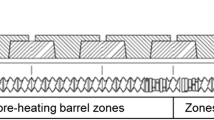Abstract
A lab scale twin roll press machine was developed for pelletizing natural gas hydrate powder. Ice and hydrate powder were used for the pellet extrusion system. The effects of feeding pressure, pressure ratio, and rotating speed of the twin roll were investigated for producing high strength and stiffness hydrate pellets. The compressive strength and stiffness of pellet increased with increasing feeding pressure and rotation speed. In particular, there was a relatively large increase in the stiffness with an increase in rotating speed, and a relatively large increase in strength with increasing feeding pressure. The production ratio of pellets largely depended on the rotating speed of the twin roll. The results indicate the promising future of solid transportation of natural gas.
Similar content being viewed by others
References
T. A. Strobel, K. C. Hester, C. A. Koh, A. K. Sum and E. D. Sloan Jr, Properties of the clathrates of hydrogen and developments in their applicability for hydrogen storage, Chemical Physics Letters, 478 (4–6) (2009) 97–109.
Y. H. Sun, R. Jia, W. Guo, Y. Q. Zhang, Y. H. Zhu, B. Li and K. Li, Design and experimental study of the steam mining system for natural gas hydrates, Energy & Fuels, 26 (12) (2012) 7280–7287.
D. Y. Koh, H. Kang, D. O. Kim, J. Park, M. Cha and H. Lee, Recovery of methane from gas hydrates intercalated within natural sediments using CO2 and a CO2/N2 gas mixture, Chem. Sus. Chem., 5 (8) (2012) 1443–1448.
Y. Song, L. Yang, J. Zhao, W. Liu, M. Yang, Y. Li, Y. Liu and Q. Li, The status of natural gas hydrate research in China: A review, Renewable and Sustainable Energy Reviews, 31 (0) (2014) 778–791.
N. Kim and C. Kim, Dissolution behavior and hydrate effect on CO2 ocean sequestration, J. Mech. Sci. Technol., 19 (5) (2005) 1216–1225.
P. Babu, R. Kumar and P. Linga, A new porous material to enhance the kinetics of clathrate process: application to precombustion carbon dioxide capture, Environmental Science & Technology, 47 (22) (2013) 13191–13198.
Y. H. Lee, B. H. Koh, H. S. Kim and M. H. Song, Compressive strength properties of natural Gas hydrate pellet by continuous extrusion from a twin-roll system, Advances in Materials Science and Engineering (2013) 6.
J. Javanmardi, K. Nasrifar, S. H. Najibi and M. Moshfeghian, Economic evaluation of natural gas hydrate as an alternative for natural gas transportation, Applied Thermal Engineering, 25 (11–12) (2005) 1708–1723.
X. Lv, B. Shi, Y. Wang and J. Gong, Study on has hydrate formation and hydrate slurry flow in a multiphase transportation system, Energy & Fuels, 27 (12) (2013) 7294–7302.
M. T. Montgomery, T. J. Boyd, C. L. Osburn, R. E. Plummer, S. M. Masutani and R. B. Coffin, Desalination technology waste streams: effect of pH and salinity on metabolism of marine microbial assemblages, Desalination, 249 (2) (2009) 861–864.
C. A. Koh, E. D. Sloan, A. K. Sum and D. T. Wu, Fundamentals and applications of has hydrates, Annual Review of Chemical and Biomolecular Engineering, 2 (1) (2011) 237–257.
S. H. Lim, S. B. Riffat, S. S. Park, S. J. Oh, W. Chun and N. J. Kim, Enhancement of methane hydrate formation using a mixture of tetrahydrofuran and oxidized multi-wall carbon nanotubes, International Journal of Energy Research, 38 (3) (2014) 374–379.
Y. H. Mori, J. I. Ochiai and R. Ohmura, Using submarine heat pumps for efficient gas production from seabed hydrate reservoirs, Energies, 5 (3) (2012) 599–604.
Y. P. Handa, Calorimetric determinations of the compositions, enthalpies of dissociation, and heat capacities in the range 85 to 270 K for clathrate hydrates of xenon and krypton, The Journal of Chemical Thermodynamics, 18 (9) (1986) 891–902.
J. S. Gudmundsson and A. Børrehaug, Frozen hydrate for transport of natural gas, 2nd International Conference on Natural Gas Hydrate, Toulouse, France (1996).
Author information
Authors and Affiliations
Corresponding author
Additional information
Recommended by Associate Editor Moon Ki Kim
Myung Ho Song received his B.S. and M.S. degrees in the Department of Mechanical Engineering at Seoul National University, Korea on 1983 and 1985, respectively. He got his Ph.D. in the Department of Mechanical Engineering at Purdue University, U.S.A. on 1995. He is now working as a professor in the Department of Mechanical, Robotics and Energy Engineering, Dongguk University, Korea. His main research interests are in gas hydrates, radiation through semitransparent medium, heat and mass transfer during mixture phase change and renewable energies.
Heung Soo Kim received his B.S. and M.S. degrees in the Department of Aerospace Engineering from Inha University, Korea in 1997 and 1999, respectively. He got his Ph.D. in the Department of Mechanical and Aerospace Engineering from Arizona State University in 2003. He is now working as an associate professor in the Department of Mechanical, Robotics and Energy Engineering, Dongguk University. His main research interests are in biomimetic actuators and sensors, smart materials and structures as applied to aerospace structures and vehicles.
Byung Moon Kim received his M.S. and M.S. degrees in the Department of Mechanical Engineering from Kyungpook National University, Korea in 1989 and 1992, respectively. He got his Ph.D. in the Department of Heat Energy System from Kyushu University, Japan in 1999. He is now working as an assistant professor in the Department of Mechanical System Engineering, Dongguk University. His main interesting fields are PIV(Particle image velocimetry), battery re-manufacture, thermal spray coating, jet nozzle design.
Rights and permissions
About this article
Cite this article
Song, M.H., Kim, H.S. & Kim, B.M. Influence of production parameters on gas hydrate and ice powder pelletizing. J Mech Sci Technol 29, 1181–1186 (2015). https://doi.org/10.1007/s12206-015-0230-y
Received:
Revised:
Accepted:
Published:
Issue Date:
DOI: https://doi.org/10.1007/s12206-015-0230-y




